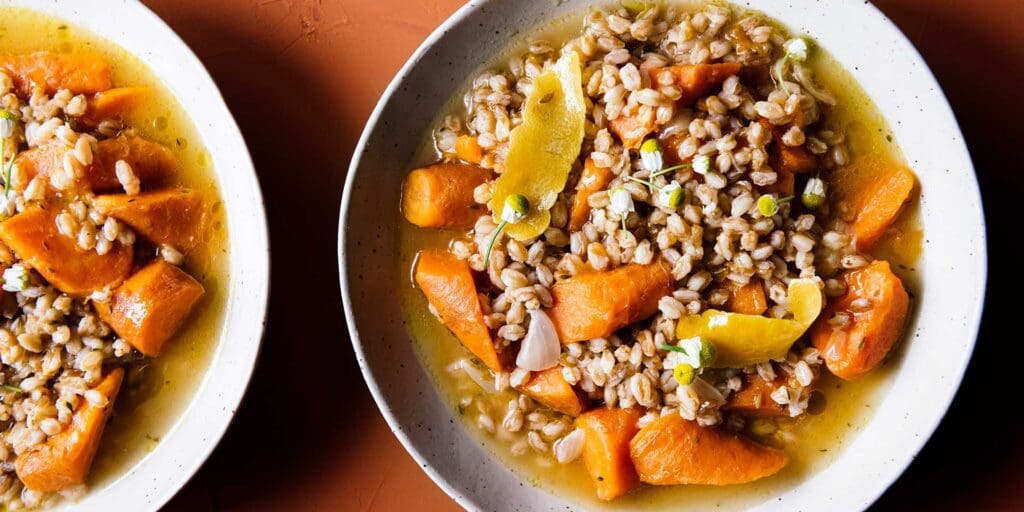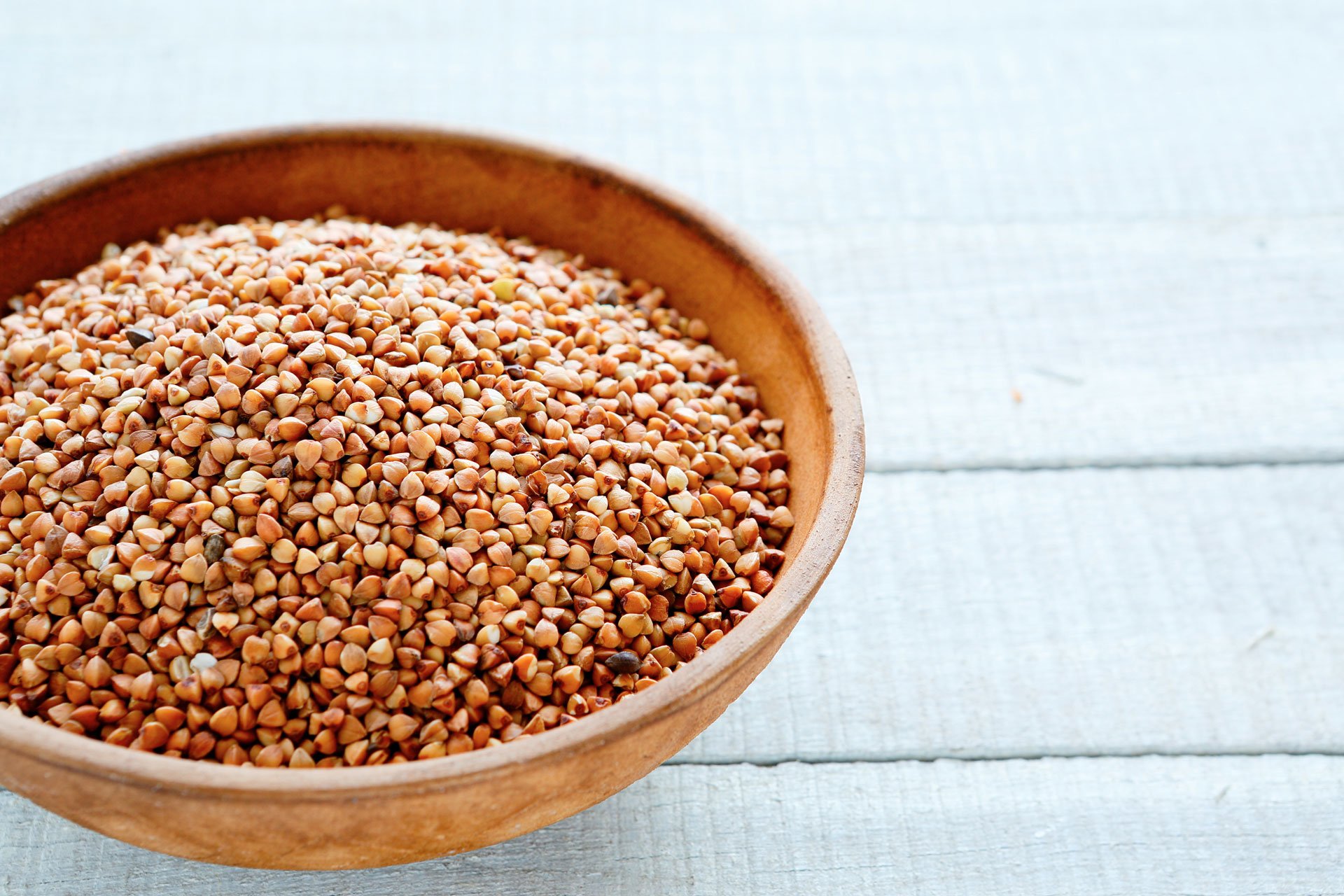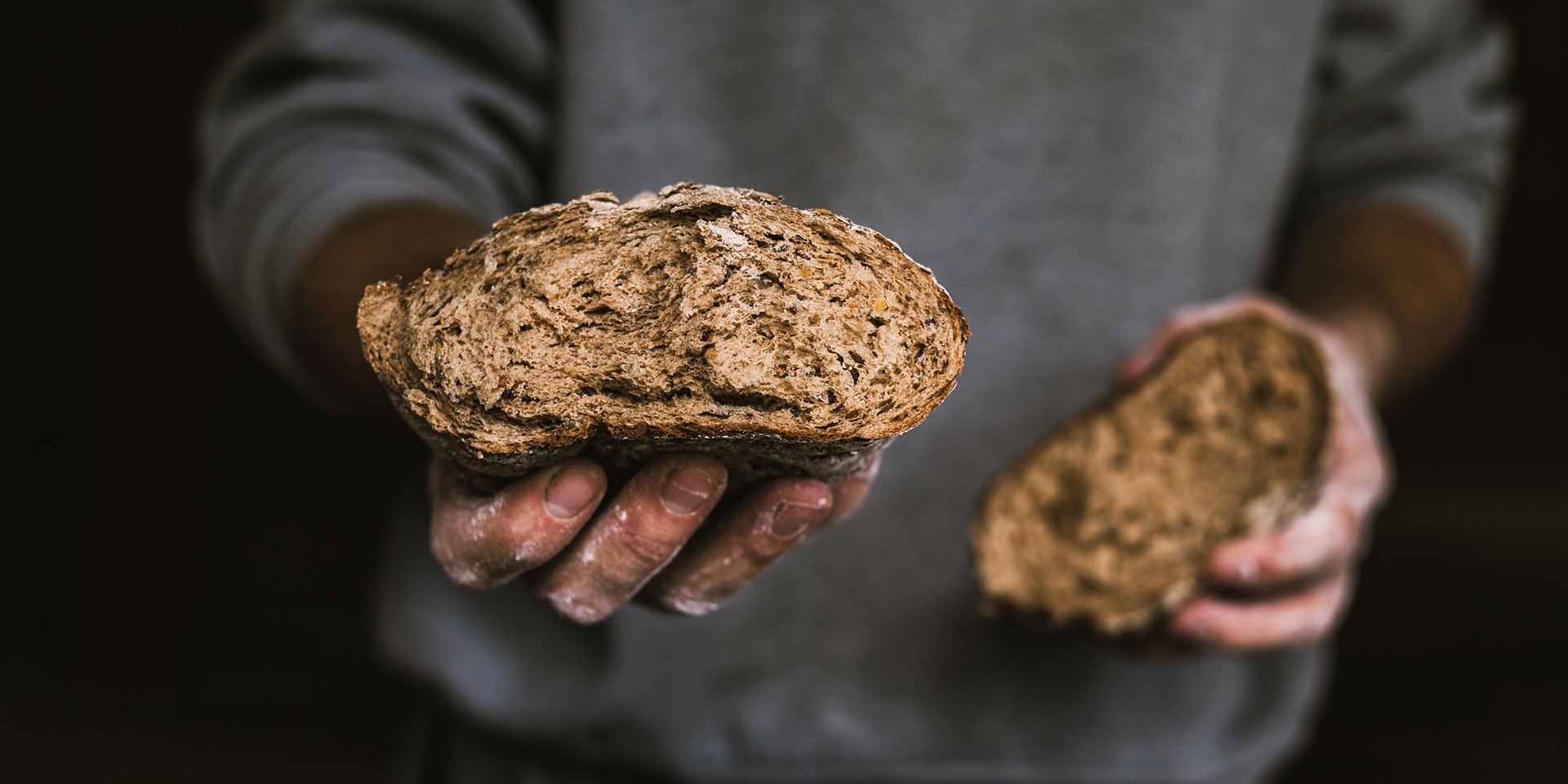Eat Healthier and Better for the Planet With These Whole Grains Cookbooks
Modern health advice is steeped in the wisdom of a diverse diet, rich in whole grains. And yet so often, meals in the US are accompanied by white rice, white bread, white pasta. Why? These pantry staples are easy to cook and familiar in flavor, texture and application. Whole grains, on the other hand, can cause trepidation or carry old reputational baggage – buckwheat and barley are hippie foods, tricky to cook and strange to eat. How much water does millet need to cook? Why is quinoa so mushy?
“The obvious reasons you should eat more grains, beans, seeds and legumes — to benefit your health and pocketbook, not to mention the environment — are not cause to be excited about them,“ Brett Anderson recently wrote in The New York Times.
Even without these preconceived notions, it may be that whole grains just haven’t come on your radar. While white and brown rice varieties pack supermarket shelves, finding alternatives such as buckwheat or amaranth can be tricky. “I never took much notice of different grains or legumes,” writes chef and cookbook author Abra Berens in her new cookbook’s introduction, a refrain many can likely relate to.
A series of new whole grains cookbooks, including Berens’ “Grist,” give Anderson and others more than enough reason to pay attention and be excited about these ingredients. Beyond the white rice, bread or pasta (or the occasional replacement of brown rice or whole wheat items), a larger world of grains provides an opportunity to expand our pantry and recipe repertoire.
As the chef at Michigan’s Granor Farm, Berens saw a vast diversity of grains being grown and began to use the “underappreciated staples” for more than hot breakfast porridge or baked goods. Portland chef Jeremy McFadden first discovered farro while in culinary school in Italy, and preferred the grain for making risotto. “Chewier, denser texture, deeper flavor, starchy enough to be creamy but not mushy. I loved it,” he writes in his new cookbook “A Season for All Grains.” “I wrote this cookbook because I want you to love whole grains as much as I do, and I want you to realize it doesn’t take a lot of effort to incorporate them into your cooking life.”
Although he incorporates whole grains like spelt, freekeh, bulgur, wheat berries, barley, millet, quinoa and more into his restaurant menus, farro is still McFadden’s favorite grain. But the most known grain outside of rice is likely barley, often used in soups and porridge or ground into flour for baking. If you start looking for whole grains, it’s likely others are stocked at your local grocer – bulgur, cornmeal and quinoa. Some, including heirloom varieties, you can only find at farmers’ markets and online purveyors. Depending on what part of the country you live in, you may be able to find locally grown grains; programs like the Heritage Grains CSA, Adagio Acres and Bluebird Grain Farms offer subscribers the opportunity to try a number of local products.
Both freekeh and fonio have become trendy in the last decade or so, as marketers have latched onto their smoky or nutty flavors and nutritional benefits. Food media have continued to rediscover these “ancient grains” over and over. In 2010, The Atlantic documented the rising interest in freekeh; nine years later a similarly titled New York Times piece “An Ancient Grain Brings the Warmth” was published. The Guardian claimed fonio would be “the grain that would defeat quinoa as king among foodies” in 2014; nearly a decade later, Civil Eats asks whether it’s the “ancient grain of the future?”
The trending on repeat might cause an eye roll, but it also begs the question of why these whole grains are always on the brink of catching on, but never quite breaking through. For fonio, one issue has certainly been availability. As Civil Eats documented, fonio is difficult to process and little infrastructure exists to support its industry. A type of millet, this native Sengalese crop has been described as “climate-crisis ready; it grows in poor soils in drought conditions with little to no inputs,” making it an attractive crop for Africa and others. Yolélé, a company that works with smallholder farmers to export fonio around the world, is one of several that is investing in new infrastructure to increase fonio production.
“Here’s the crazy thing: Although fonio has been around for over 5,000 years and is probably Africa’s oldest cultivated grain, right now it is cultivated almost exclusively by smallholder farmers who grow it for their own consumption,” writes Yolélé’s co-founder, chef Pierre Thiam. While many whole grains cookbooks focus on a variety of ingredients, Thiam, author of the new “The Fonio Cookbook,” has made it his mission to increase knowledge specifically of fonio around the world, giving lectures, including a TED talk, on the grain. His cookbook showcases the harvesting season for fonio with gorgeous photography, and includes traditional recipes from all over Africa, as well as more modern applications for the grain – think fonio croquettes stuffed with mushrooms and fonio, kale and caramelized onion frittata.
“Fonio’s subtle flavor makes it particularly well-suited for all styles of cuisines,” Thiam writes. “It can replace any grain in your favorite recipes.”
Rice, too, offers a range of possibilities beyond the usual types. “Rice has its own intrinsic grandeur,” Michael W. Twitty writes in his new cookbook “Rice.” “Connoisseurs can tell the differences between thousands of varieties.” Branch out by looking for varieties such as Carolina Gold and heirloom red, purple and white rices, which all have their own nuanced flavors and texture. Twitty suggests trying rice in classic preparations like Jollof rice and Hoppin’ John, and making use of it in bread, waffles and desserts. Berens highlights the importance of buying wild rice – which can have a heartier, nutty flavor and firmer bite – from Indigenous harvesters, honoring the traditional roots of the ingredient.
As Anderson cited in The Times, this rising popularity in heirloom grains and whole grains cookbooks is not only good for our health, but it’s also good for farmers and the environment. Unlike the industrial agriculture system of corn-soy monoculture, many of these plants can be used as natural herbicides and erosion preventers – they help build soil health and fertility. Creating a demand for alternative grains is one small way to help build a stronger, more diverse food system, as Berens writes, “creating alternative, and profitable markets for growers of all sizes.”
And don’t forget the increased nutritional benefits, one of the reasons whole grains are touted by so many health professionals. It’s fairly common knowledge that whole grains have more fiber because they include the bran, germ and endosperm. “Grains are so much more than bran delivery vehicles,” writes McFadden. Whole grains foods contain many minerals, vitamins, antioxidants and phytochemicals, and are linked to lower risks of heart disease, diabetes, certain cancers and other health problems.
"I want you to love whole grains as much as I do, and I want you to realize it doesn’t take a lot of effort to incorporate them into your cooking life.”
Not sure how to start cooking and eating new grains? “Just start,” Berens writes, advising people to try their favorite recipe with whatever grain feels the most familiar.” Then make that favorite thing with a new-to-you or different grain and explore the similarities and differences.” Many whole grains can be cooked in the same ways, making them interchangeable in recipes and cooking techniques.
Much as Berens stressed in her first cookbook, “Ruffage,” adding whole grains into your meals isn’t about sticking exactly to the recipes. Just as Thiam writes about fonio, you can easily substitute many of these grains for each other. Fried buckwheat in Berens salad recipe can be swapped for fried bulgur, if that’s what you have on hand. For a salad, boiled barley or boiled buckwheat can both work equally well.
One of the most useful tips both Berens and McFadden provide solves the age-old answer of how much water you need to cook grains. The answer: a lot. They both prefer the boil-like-pasta method for cooking whole grains, boiling at least four times the amount of salted water as grains and cooking the grains to desired texture. McFadden suggests checking the grains at least 5 minutes before the lower end of the suggested cooking time because whole grains can vary from producer to producer (even batch to batch) for how much water and time they need cooking.
And when all else fails, Berens suggests turning whole grains into fritters: “Even the most intimidating (or sanctimonious) ingredient can’t be taken too seriously when it’s deep fried.”
4 New Whole Grains Cookbooks
Go deeper into the world of freekah, fonio and more with these whole grains cookbooks:
“The Fonio Cookbook: An Ancient Grain Rediscovered” by Pierre Thiam
Fonio, a Senegalese native grain, is the latest ancient grain to take the culinary world by storm, in large part thanks to chef Pierre Thiam, who has championed the gluten-free grain with Yolélé, the company he co-founded, buying fonio from smallholder farmers and exporting it around the world. In his new cookbook, “The Fonio Cookbook,” he presents traditional West African dishes, including Jollof fonio and chicken Yassa, as well as more modern applications, showing how fonio can be substituted in for nearly any grain with pilaf, paella and croquette preparations. The cookbook also documents the fonio growing season in Senegal and the rich cultural history of the grain.
“Grains for Every Season: Rethinking Our Way with Grains” by Joshua McFadden
A follow-up to his wildly successful “Six Seasons” cookbook, Portland chef Joshua McFadden is back with his second book, focused entirely on his love for grains. Admitting he is no grain expert, McFadden skips some of the more esoteric grains like amaranth and focuses on the ingredients he knows and loves – barley, brown rice, buckwheat, corn, millet, oats, quinoa, rye, wild rice and different varieties of wheat, including bulgur, farro, freekeh, spelt, wheat berries, and whole wheat flour. With 200 recipes, McFadden explores why he loves these particular grains, sharing advice from producers and other chefs and showing the flexibility of the ingredients to help readers fall in love with them.
“Rice: A Savor the South Cookbook” by Michael W. Twitty
A small handbook by food historian and cook Michael W. Twitty, “Rice” provides an introductory chapter on the history of rice cultivation in the American South, and offers information on historically relevant dishes that came through these places. Beyond, Twitty provides 50-plus recipes, pulled from Creole, Acadian, soul food, Low Country and Gulf Coast kitchens. The book is part of a collection of single-subject volumes exploring Southern cuisine from the University of North Carolina Press and includes both classic rice dishes such as red beans and rice and groundnut stew, and modern, inventive ideas, using rice in breads and desserts. Additional thoughts and facts about rice — such as Twitty’s favorite types of rice and the memories attached to these recipes — are peppered throughout.
“Grist: A Practical Guide to Cooking Grains, Beans, Seeds, and Legumes” by Abra Berens
In her second cookbook, Michigan-based chef, writer and former farmer focus her attention on the world of beans, grains and seeds. “Grist” reads like an encyclopedia, with plant information; tips for big batch cooking; 125 easy-to-follow recipes for 29 different grains, legumes and seeds; solutions for common problems; and informative farmer interviews, explaining how many of these ingredients are grown, harvested and come to market.

RECIPE: Carrot Farro Stew with Lemon Chamomile Oil
Abra Berens, “Grist: A Practical Guide to Cooking Grains, Beans, Seeds, and Legumes”
My friend Annie Compercchio once sent me a jar of chamomile blossoms from her garden, which were lovely and smelled amazing but left me at a bit of a loss on how to incorporate them into my food. Somehow, I arrived at steeping them in oil with a lot of lemon zest, and the smell immediately reminded me of wild carrot flowers. Now the two flavors are permanently combined in my mind. Should you not have a darling friend to send you hand-harvested and hearth-dried chamomile, substitute any sort of chamomile tea. Simply cut open the bag and forge on.
As with all stews, cooking them on the stovetop will go faster. Cooking in the oven will take longer but requires less checking along the way.
Ingredients
Olive oil
5 sprigs thyme (optional)
1 cup [200 g] farro
2 lb [900 g] carrots, cut into ½ in [12 mm] chunks
1 onion (about 8 oz [225 g]), thinly sliced
Salt
1 cup [250 ml] white wine
1 recipe chamomile lemon oil (see below)
10 sprigs parsley, roughly chopped (optional)
Method
1. In a medium Dutch oven, heat a glug of olive oil over medium-high heat until it begins to shimmer, about 1 minute. Add the thyme and farro and briefly fry, 1 to 2 minutes. Add the carrot and onion with a big pinch of salt, toss to coat, and lower the heat to medium. Add the white wine and cook until reduced by half.
2. Add 3 cups [750 ml] of water, bring to a boil, turn down to a simmer, and cook, half covered with a lid, until both the carrots and farro are tender, 30 to 60 minutes depending on the type of farro.
3. To serve, transfer the farro stew to a serving dish and drizzle the stew liberally with the chamomile lemon oil and a flourish of chopped parsley (if using). Taste and adjust seasoning.
RECIPE: Chamomile Lemon Oil
Ingredients
¼ cup [60 ml] neutral oil
1 tsp chamomile blossoms or dried tea
Zest of 1 lemon
¼ cup [60 ml] olive oil
Method
1. In a small saucepan, heat the neutral oil over medium-high heat until it begins to shimmer, about 1 minute. Add the chamomile and lemon zest, turn the heat to low, and allow them to bloom in the hot oil until fragrant, about 1 minute.
2. Remove from the heat and add the olive oil to cool the neutral oil. Allow to steep for 10 minutes before using.
Reprinted from Grist: A Practical Guide to Cooking Grains, Beans, Seeds, and Legumes by Abra Berens with permission from Chronicle Books, 2021. Photographs © EE Berger.
Get the latest food news, from FoodPrint.
By subscribing to communications from FoodPrint, you are agreeing to receive emails from us. We promise not to email you too often or sell your information.
Top photo © EE Berger.
More Reading
Create Less Waste and More Color in Your Kitchen with Natural Dyes
April 27, 2023
Post-UN Water Conference, When You Think About Your Next Meal, Think About Water
April 18, 2023
Community Supported Fisheries Prove Seafood Can Be Local, Too
February 27, 2023
Is it Possible to Decolonize the Wine Industry?
October 24, 2022
Dairy, Drought and the Drying of the American West
October 21, 2022
Can the California Plastics Law Solve Our Plastic Problem?
September 15, 2022
What’s for Dinner? Protein — and its Large Water Footprint
June 2, 2022
New Congressional Report Exposes How Meatpackers Manipulated Policy to Dodge COVID-19 Restrictions
May 18, 2022
When Did Vegan Cheese Get So Good?
April 4, 2022


